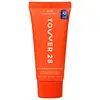What's inside
What's inside
 Key Ingredients
Key Ingredients

No key ingredients
 Benefits
Benefits

 Concerns
Concerns

 Ingredients Side-by-side
Ingredients Side-by-side

Water
Skin ConditioningGlycerin
HumectantCetyl Ethylhexanoate
EmollientCaprylic/Capric Triglyceride
MaskingPropanediol
Solvent1,2-Hexanediol
Skin ConditioningGlyceryl Stearate
EmollientCetearyl Alcohol
EmollientMicrocrystalline Cellulose
AbsorbentSodium Polyacrylate Starch
AbsorbentSclerotium Gum
Emulsion StabilisingTriolein
Skin ConditioningPotassium Cetyl Phosphate
EmulsifyingBehenyl Alcohol
EmollientAllantoin
Skin ConditioningCeramide NP
Skin ConditioningGlyceryl Dioleate
EmollientCellulose Gum
Emulsion StabilisingSodium Phytate
Pentylene Glycol
Skin ConditioningSodium Acetylated Hyaluronate
HumectantSodium Hyaluronate
HumectantSodium Hyaluronate Crosspolymer
HumectantHydrolyzed Sodium Hyaluronate
Skin ConditioningEthylhexylglycerin
Skin ConditioningWater, Glycerin, Cetyl Ethylhexanoate, Caprylic/Capric Triglyceride, Propanediol, 1,2-Hexanediol, Glyceryl Stearate, Cetearyl Alcohol, Microcrystalline Cellulose, Sodium Polyacrylate Starch, Sclerotium Gum, Triolein, Potassium Cetyl Phosphate, Behenyl Alcohol, Allantoin, Ceramide NP, Glyceryl Dioleate, Cellulose Gum, Sodium Phytate, Pentylene Glycol, Sodium Acetylated Hyaluronate, Sodium Hyaluronate, Sodium Hyaluronate Crosspolymer, Hydrolyzed Sodium Hyaluronate, Ethylhexylglycerin
Aloe Barbadensis Leaf Juice
Skin ConditioningGlycerin
HumectantPropanediol
SolventPropylene Glycol
HumectantIsoamyl Laurate
EmollientCentella Asiatica Leaf Extract
Skin ConditioningSodium Acrylate/Sodium Acryloyldimethyl Taurate Copolymer
Emulsion StabilisingBetaine
HumectantSqualane
EmollientPhenoxyethanol
PreservativeIsohexadecane
EmollientPolysorbate 80
EmulsifyingCaprylyl Glycol
EmollientAllantoin
Skin ConditioningSodium Benzoate
Masking
 Reviews
Reviews

Ingredients Explained
These ingredients are found in both products.
Ingredients higher up in an ingredient list are typically present in a larger amount.
Allantoin is a soothing ingredient known for its protective and moisturizingg properties. Because of this, it is often added to products with strong active ingredients.
Studies show higher concentrations of this ingredient can promote wound healing.
Though it can be derived from the comfrey plant, allantoin is produced synthetically for cosmetic products to ensure purity.
Learn more about AllantoinGlycerin is already naturally found in your skin. It helps moisturize and protect your skin.
A study from 2016 found glycerin to be more effective as a humectant than AHAs and hyaluronic acid.
As a humectant, it helps the skin stay hydrated by pulling moisture to your skin. The low molecular weight of glycerin allows it to pull moisture into the deeper layers of your skin.
Hydrated skin improves your skin barrier; Your skin barrier helps protect against irritants and bacteria.
Glycerin has also been found to have antimicrobial and antiviral properties. Due to these properties, glycerin is often used in wound and burn treatments.
In cosmetics, glycerin is usually derived from plants such as soybean or palm. However, it can also be sourced from animals, such as tallow or animal fat.
This ingredient is organic, colorless, odorless, and non-toxic.
Glycerin is the name for this ingredient in American English. British English uses Glycerol/Glycerine.
Learn more about GlycerinPropanediol is an all-star ingredient. It softens, hydrates, and smooths the skin.
It’s often used to:
Propanediol is not likely to cause sensitivity and considered safe to use. It is derived from corn or petroleum with a clear color and no scent.
Learn more about Propanediol